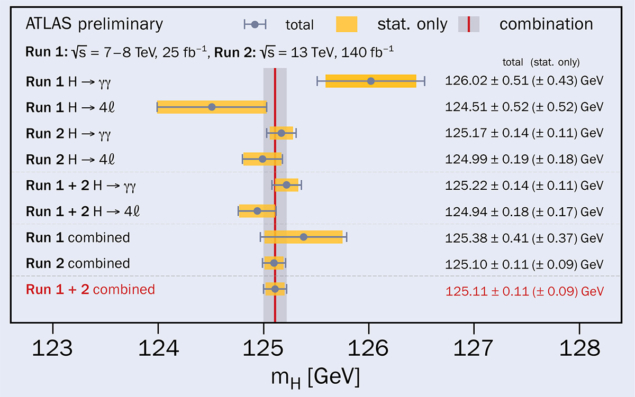A report from the ATLAS experiment.

Since the discovery of the Higgs boson in 2012, its di-photon and four-lepton decays have played a crucial role in characterising its properties. Despite their small branching ratios, these decay channels are ideal for accurate measurements due to the excellent resolution and efficient identification of photons and leptons provided by the ATLAS detector.
The Higgs-boson mass (mH) is a free parameter of the Standard Model (SM) that must be determined experimentally. Its value governs the coupling strengths of the Higgs boson with the other SM particles. It also enters as logarithmic corrections to the SM predictions of the W-boson mass and effective weak mixing angle, whose precise measurements allow the electroweak model to be tested. Moreover, the Higgs mass determines the shape and energy evolution of the Brout–Englert–Higgs potential and thus the stability of the electroweak vacuum. A precise measurement of mH is therefore of paramount importance.
ATLAS has recently published a new result of the Higgs-boson mass in the H → γγ decay channel using proton–proton collision data from LHC Run 2 (2015–2018). The measurement requires a careful control of systematic uncertainties, primarily arising from the photon energy scale. The new analysis has achieved a substantial reduction by more than a factor of three of these uncertainties compared to the previous ATLAS result based on the 2015 and 2016 dataset. That improvement became possible after extensive efforts to refine the photon energy-scale calibration and associated uncertainties.

The calibration benefited from an improved understanding of the energy response across the longitudinal ATLAS electromagnetic calorimeter layers and of nonlinear electronics readout effects. A new correction was implemented in the extrapolation of the precisely measured electron-energy scale in Z → e+e– events to photons, to account for differences in the lateral shower development between electrons and photons. These improvements reduced the systematic uncertainty in the mass measurement by about 40%. Moreover, the extrapolation of the electron energy scale from Z → e+e– events to photons originating from the Higgs boson was further refined, and transverse-momentum dependent effects were corrected. Taken together, the improvements allowed ATLAS to measure the Higgs-boson mass in the di-photon channel with a precision of 1.1 per mille.
The new di-photon result was combined with the mH measurement in the H → ZZ* → 4ℓ decay using the full Run 2 dataset, published by ATLAS in 2022, and with the corresponding Run 1 (2011–2012) measurements (see figure 1). The resulting combined Higgs-boson mass mH = 125.11 ± 0.11 GeV has a precision of 0.9 per mille and is dominated by statistical uncertainties that will further reduce with the Run 3 data.
The high level of readiness and excellent performance of the ATLAS detector also allowed first measurements of the fiducial Higgs-boson production cross-sections in the H → γγ and H → ZZ* → 4ℓ decay channels using up to 31.4 fb–1 of data collected in 2022. Their extrapolation to full phase space and combination gives σ(pp → H) = 58.2 ± 8.7 pb, which agrees with the SM prediction of 59.9 ± 2.6 pb (see figure 2).
With the continuation of Run 3 data taking, the precision of the 13.6 TeV cross-section measurements will improve and the combination with the Run 2 data will allow the exploration of Higgs-boson properties with growing sensitivity.
Further reading
ATLAS Collab. 2023 ATLAS-CONF-2023-036.
ATLAS Collab. 2023 CERN-EP-2023-128.
ATLAS Collab. 2023 Phys. Lett. B 843 137829.
ATLAS Collab. 2023 ATLAS-CONF-2023-037.
ATLAS Collab. 2023 arXiv:2306.11379.








